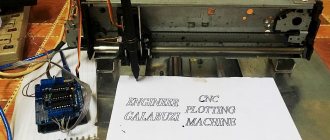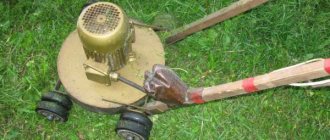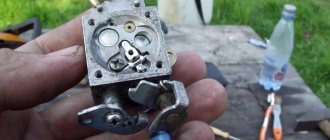Walk-behind tractors are quite serious and expensive gardening equipment.
If you want it to fully perform its functions, serve for a long time and reliably, then you need to carefully care for it and follow all operating recommendations prescribed by the manufacturer. When you bought equipment, it is important to know how to start the walk-behind tractor correctly. There is a certain sequence of actions, consisting of preparing the equipment for launch and its immediate launch.
How to start a walk-behind tractor correctly?
Walk-behind tractors are quite serious and expensive gardening equipment. If you want it to fully perform its functions, serve for a long time and reliably, then you need to carefully care for it and follow all operating recommendations prescribed by the manufacturer. When you bought equipment, it is important to know how to start the walk-behind tractor correctly. There is a certain sequence of actions, consisting of preparing the equipment for launch and its immediate launch.
Preparatory stage
So, you are the owner of a new walk-behind tractor for caring for your vegetable garden, orchard, and even your personal plot. The first thing to start with is checking the oil level. Even if you are sure that there is enough of it there or the store assured you that it is filled in full, you still need to check. If there is not enough oil, you can simply ruin the engine. Also, the car may not start if the oil was filled a long time ago and has already deteriorated. Some engine models, such as Subaru or Lon Chin, have a special sensor that shows exactly how much oil is in your vehicle.
After this, you need to add fuel. In the operating instructions you will find information about which gasoline is suitable for your model of walk-behind tractor. You can also check this information with sellers. Another important point concerns two-stroke engines, where gasoline must be diluted with oil in a certain proportion.
Only after this can you proceed directly to inspecting the entire walk-behind tractor. That is, you must check all connections, steering wheel and wheel fastenings, clutch and gas cables, and so on.
Why might the motor cultivator not start?
The reason for this may be the presence of old oil.
In this case, white exhaust gases will come from the engine. To solve the problem, you need to immediately drain the old oil and fill in new oil. Often the unit may not start due to lack of oil. Therefore, before starting the engine, you need to check the amount of fluid in the tank. Some models have low oil level protection. In such cases, a special sensor blocks the start and the engine stalls.
Remember that each engine runs on a specific brand of gasoline. To refuel a two-stroke engine, the fuel mixture must be prepared separately. It consists of oil and gasoline mixed in a certain proportion. To refuel your equipment, you need to buy only the purest gasoline at proven gas stations. The service life of the fuel system elements and the entire engine as a whole depends on its quality.
Step-by-step instructions for starting a walk-behind tractor
After all the checks, you are convinced that the oil is filled in in sufficient quantities, gasoline or diesel fuel matches the model of your walk-behind tractor, and all fasteners and systems are in correct and working condition. Now we will tell you how to start a walk-behind tractor:
- gasoline walk-behind tractor. You need to open the gasoline tap, and the choke lever should be in the “Start” position, and also turn off the ignition. After this, you need to pump the starter a couple of times, turn on the ignition, and pull the starter again. In this state, the walk-behind tractor will start, and you must move the choke lever to the “Work” position. If your vehicle model has an electric starter, you can immediately turn on the ignition and start it;
- diesel walk-behind tractor. Diesel walk-behind tractors are known to be a little more difficult to start. Moreover, if you plan to work on it in winter, then you should be aware that diesel fuel tends to freeze. Therefore, you first need to warm up the equipment, and only then apply loads. So, if the unit is new, then its entire system is aired. To pump it up, you need to work with the starter. If the starter is manual, you can, of course, pull it yourself, or you can do the following procedure. Unscrew the fuel supply valve and unscrew each supply connection from it. In this case, you need to unscrew it, wait until the fuel flows and tighten it again. Continue doing this until you reach the nozzle. To manually start, open all valves and set the gas to the middle position. Hold the decompressor with your finger, squeeze it out and pump it several times. After this, release it and pull until it returns to its original position. Now press the decompressor again, and without supporting it, press the starter. The walk-behind tractor should start.
As can be seen from the above, gasoline and diesel walk-behind tractors start up differently. It is important to carefully read the operating instructions and strictly follow the manufacturer's advice. You also need to use only high-quality fuel and oil that is suitable for the type of your walk-behind tractor model. And then you will not encounter problems when starting and further working on the machine.
Unit gearbox
There are two types of categories of Neva walk-behind tractors: using a classic gearbox or MultiAGRO. With the help of a gear-chain part, the following occurs:
- Increase in 1.5 times the power of the unit. This makes it possible to save time and effort during the work process.
- Increases torque to maximum at 1.8 km/h. Due to this, the walk-behind tractor is used when clearing snow and mowing the lawn.
- Ability to work at a speed of 13 km/h.
- Possibility to disable one axle shaft. This increases the maneuverability of the device and simplifies control.
If we talk about each gearbox separately, then the classic type has a standard number of gears. And this does not make it possible to adapt to the type of soil.
With the MultiAGRO gearbox, gear shifting is carried out using the handle of the unit. The number of gears will be greater than in the previous version. MultiAGRO allows you to use equipment for a long time without failures. Due to its maneuverability, it can handle complex and hard-to-reach areas.
On a note! The classic gearbox is installed on the MB-23 SD model. Despite the low power, it has high traction qualities. This is the only walk-behind tractor with a diesel engine.
Starting a walk-behind tractor
Motoblocks today have become an almost integral part of agriculture.
Many farmers have transferred all the most difficult and exhausting work to this technique. Now she prepares the land for planting crops, waters the plants, digs up potatoes, transports goods, and even cares for the territory of her personal plot. However, like any other equipment, walk-behind tractors require careful treatment from the moment they are first started. If you want them to serve you as long as possible, you must know all the nuances of starting a walk-behind tractor.
In this article we will talk about how to start a walk-behind tractor correctly and how to do it after storage during the winter. After all, if you start it incorrectly, you may have serious problems that will require repair of the unit.
Required Tools
To adjust the carburetor valves, you will need a minimum list of handy tools:
- razor blade or feeler gauge;
- minus screwdriver;
- spanner wrench
Using these simple tools you can adjust most carburetors.
People invented snowmobiles that allow you to drive on snowy roads as quickly as possible, without much effort. is quality, speed and reliability.
Gardening and caring for plants and trees have always been considered one of the most difficult types of work, as they require significant time and effort. - the ideal solution for your garden.
Labor-intensive gardening work can now be done using a walk-behind tractor. learn how to plant potatoes with a walk-behind tractor.
It is important to understand that valve adjustment means setting the optimal clearance, which is directly stated in the operating instructions for each specific model.
How to start a walk-behind tractor correctly?
After you have bought your walk-behind tractor, you should not start it right away, even if the consultants assure you that the equipment is completely ready for use.
You need to start with the preparatory work. To do this, you first need to check the engine oil level. There should be a sufficient amount of it. If this is not the case, the oil needs to be added. If you start the engine without oil, it will immediately fail. On sale you can find walk-behind tractors, such as Caiman, that have an oil level sensor. If there is little or no lubricant, the engine simply will not start. This is very convenient and significantly extends the life of your equipment.
After this, you need to add fuel. When purchasing, check with your consultant or in the operating instructions for the type of gasoline that is suitable for your model of walk-behind tractor. If the unit has a two-stroke engine, then the fuel must be diluted with oil in a certain ratio. Never use low-quality fuel or fuel that is not suitable for your walk-behind tractor.
The final stage of preparing the machine for launch is checking all connections and fastenings. All moving elements should not be tightly tightened - their operation should be elastic, but smooth.
Starting a diesel and gasoline walk-behind tractor is slightly different. The gasoline unit starts like this:
- open the gasoline tap;
- the choke lever must be in the “start” position;
- the ignition must be turned off;
- pump with a mechanical starter a couple of times;
- now you need to turn on the ignition;
- pull the starter again.
Main characteristics
The Neva walk-behind tractor is used for secondary tillage. The design includes a shank that pierces the soil, grips it and turns it over. When viewed from a design point of view, the technique refers to machines that use the rotational movement of disks or teeth. The rotary cultivator of this line is a perfect example.
Walk-behind tractors are used before sowing or after the crop has begun to grow to remove weeds . Thus, operator-controlled disturbance of the soil layer near the plants kills unnecessary plants and uproots them. Neva gear-type products are often similar in shape to chisel plows, but they have different purposes. The technique works close to the surface, while the plow is deep below the surface.
All the company's units can be described as compact equipment with a low center of gravity.
Thanks to this design, it is more convenient to work on a walk-behind tractor; there is no risk that the equipment may lose balance and roll over.
All models have an engine from Subaru , and along with it an electronic switching system is installed. All units have a front wheel for moving, and the compact dimensions allow the walk-behind tractor to be transported in the trunk of a car.
Power may vary depending on model. This figure is in the range from 4.5 to 7.5 horsepower. The working width is from 15 to 95 cm, the immersion depth of the cutters is up to 32 cm, most often the fuel tank volume is 3.6 liters, but on some models it reaches 4.5 liters.
The gearbox installed in the Neva walk-behind tractors is three-speed and V-belt. This equipment runs on AI-95 or 92 gasoline ; other fuel cannot be used.
The type of oil depends on the conditions in which the walk-behind tractor is operated. This could be SAE30 or SAE10W3.
Some walk-behind tractors have an engine with a cast-iron sleeve; simpler vehicles have one speed forward and the same speed backward. There are multi-speed units that can be switched between three speeds. Most walk-behind tractors can replace a small tractor ; they can not only cultivate the soil, but also transport various loads. Such equipment is capable of accelerating from 1.8 to 12 kilometers per hour; accordingly, the models have different motors.
On average, a semi-professional engine is designed to operate without breakdown for up to 5 thousand hours. The housing, made of aluminum, protects against moisture and dust.
Starting a walk-behind tractor without a starter
In walk-behind tractors, certain elements often fail. Starters are one of the first to break. However, this does not in any way affect the operation of the unit, or even its startup. It is only important to know some secrets:
- Remove the damaged part;
- You will need a strong rope, approximately 1 meter long;
- In place of the former starter there is a round element, on the wall of which you can see a hole into which you need to stretch the rope and securely fasten it;
- The rope needs to be wrapped around this round piece several times. As a result, you should be left with a cable about 40 cm long.
To start the engine, you need to pull the rope hard. If nothing works the first time, you will have to repeat all the steps again, since the rope does not remain on the part.
Starting a walk-behind tractor after winter
Owners of walk-behind tractors often encounter this problem when the equipment does not want to start after wintering.
This is due to storage conditions. If the car was in a cold room with high humidity, then you may end up with a number of serious breakdowns. Before the first start in the spring, you must completely change the oil and fuel. Ensuring that liquids are at ambient temperature is extremely important.
You may encounter that the walk-behind tractor refuses to start immediately. And this is quite normal. Let the equipment warm up a little. It should warm up even after starting the engine.
If the start of the walk-behind tractor still fails, you need to perform the following steps:
- Bleed the fuel system. There could be residues from gasoline or diesel in it;
- check the spark plug. The contact can even be cleaned a little with sandpaper;
- Check all wiring to ensure there are no breaks or damage.
Self-repair of elements and components
Difficulties in starting the engine may arise due to air getting into the fuel supply system. If you cannot the cultivator
To do this, you will need to open the fuel supply valve and unscrew all connections of the fuel system. At the end, the injectors are unscrewed and purged. But what to do if even after this the equipment refuses to start? You may have made a number of mistakes when preparing fuel for refueling and inspecting the unit.
Most cases are related:
- With the inability of the air filter to pass air;
- With a plug in the holes of the tank cover;
- With a clogged fuel supply channel;
- With a broken carburetor.
After unsuccessful attempts to start the cultivator, you should check the spark plug - it is quite possible that it was filled with fuel mixture.
In this case, you will need to dry the part, bleed the cylinder, screw in the spark plug and try to start the unit. As a rule, after this the cultivator motor starts, but if this does not help, the spark plug will need to be replaced.
Sources:
https://interio-style.ru/kak-zavesti-motoblok-neva/ https://ros-tile.ru/motokultivatory/kak-zavesti-motokultivator
Features of launching some models of walk-behind tractors
Different models of walk-behind tractors start in different ways. In order not to encounter difficulties, you should carefully read the instructions, where everything will be described in detail.
So, to start the Neva walk-behind tractor, you need to turn the ignition switch to the “on” position. After this, you open the gasoline valve and close the choke valve. The throttle should be at approximately ¾ of the maximum setting. Pull the starter and then open the choke. If you start the walk-behind tractor in the cold season, then you need to open the damper gradually.
The Ural walk-behind tractor starts up quite simply too. The gear shift knob should be in neutral and the gas tank should be open. Then close the throttle and choke, and then start the engine.
The Patriot unit starts up in this way. The throttle should be in the maximum position. You need to pull the cord a couple of times to purge, and then a few more times, but sharply and briefly, to start the motor. Rotate the throttle to adjust it.
How to start a walk-behind tractor - in detail for beginners and more
Any branded walk-behind tractor consists of many complex mechanisms that are activated when the built-in power unit is started. When the engine is turned on, the components of the agricultural machine are subject to increased load, so the working life of each of the factory systems of the walk-behind tractor directly depends on the correct start of the standard motor. To reduce the load and extend their service life, the user must learn the correct procedure when starting the engine, taking into account different weather and operating conditions.
How to start a walk-behind tractor without a starter?
In some cases, operation of the walk-behind tractor becomes impossible due to a breakdown of the trigger mechanism. It can fail anywhere, including in a field, far from home. To solve the problem and start the walk-behind tractor, you don’t always need to take it back to the garage.
Sometimes the design of agricultural units makes it possible to start their power unit without using a starter.
To do this you need:
- Unscrew the screws and remove the trigger mechanism;
- Clean the area under the standard starter, removing dirt and moisture from it;
- Under the starter there is a crown necessary for permanent connection of the engine crankshaft with the starter drum. You will need to wind any cable around the rim of this crown, making 4–5 complete windings around the element;
- Lightly pull the free end of the cord towards you until there is resistance - this means that the piston has risen up;
- Turn off the decompressor by moving its lever to the zero position;
- Pull the cable sharply towards you.
When starting a walk-behind tractor without a working starter, it is strictly forbidden to wrap the free end of the cord around your finger or wrist. This can lead to serious consequences, including a fracture of the phalanx of the finger. In addition, when the engine is turned on, the cord used should not get inside the crown, as it can be pulled into the engine compartment by the crankshaft.
Lifan 6.5
Adjusting the valves on a walk-behind tractor involves setting the correct gap under the valves. The sequence of actions will be as follows:
- Remove the casing to get to the flywheel.
- Remove the valve cover. Below it there are two valves - inlet and outlet.
- To check the intake valve clearance, you will need a 0.15 mm feeler gauge, and for the exhaust valve, a 0.2 mm feeler gauge. When adjusted correctly, the dipstick should pass under the valve quite freely.
- To adjust, loosen the fastening nuts using a wrench. We insert the dipstick between the valve and the piston so that it does not slip, but is held tightly enough in this position. We tighten the nut.
- Replace the valve cover and flywheel housing.
Valve of Lifan 6.5 walk-behind tractor
How to start walk-behind tractors of popular brands?
Depending on the design features and manufacturer, the launch of agricultural units can be carried out in one or another sequence. It is important to remember this, since the wrong algorithm of actions can gradually lead to serious equipment failure.
Motoblock Neva - how to start it yourself?
Before directly starting the engine, you need to check the oil level in its crankcase. To do this, you need to unscrew the filler cap located in the front part of the power unit. At the end of the plug there is a threaded probe. If the oil slick reaches this thread, then there is enough lubrication to operate the engine.
To properly start the Neva walk-behind tractor, you must:
- Turn the ignition switch to the “On” position;
- Open the fuel supply valve;
- Close the standard throttle valve;
- Set the accelerator lever to approximately 3/4 of the maximum permissible speed;
- Pull the starter cable towards you until resistance appears;
- Pull the starter cable sharply towards you - as a result, the engine should start and stall instantly;
- Slowly open the throttle valve;
- Pull the starter cable a few more times until the engine starts and starts idling.
You can turn off the engine of the Neva walk-behind tractor only when it is idling - otherwise the risk of failure of the standard magneto will increase.
How to start a Ural walk-behind tractor?
Before starting a Ural walk-behind tractor, you need to make sure that its air filter is completely clean. You also need to inspect the spark plug - agricultural machinery of this brand is characterized by frequent leakage of engine oil from a separate tank into the engine cylinder.
Replacing the seals will help solve this problem for a short time, but they last for about 20 hours of operation.
To start the Ural walk-behind tractor, you need:
- Move the throttle control lever to the “Closed” position:
- Set the accelerator to minimum speed;
- Turn on the fuel supply valve;
- Slowly pull the starter rope until resistance appears;
- Pull the starter cable sharply towards you - as a result, the engine should start;
- Open the throttle and give the engine time to warm up.
After this, you can proceed to operating the walk-behind tractor on the site.
How to start a Patriot walk-behind tractor?
To extend the service life of Patriot brand walk-behind tractors, you need to fill them only with pure 92-grade gasoline. It is not recommended to use 95 fuel, since its quality at many gas stations is much lower than AI-92 gasoline. Synthetic motor oil for 4-stroke internal combustion engines is poured into the engine crankcase.
Carburetor, malfunctions, adjustment
Below is an algorithm for setting up a carburetor on a Neva walk-behind tractor with a Subaru engine.
The diagram shows three screws that are responsible for the amount of fuel supplied.
- Screw 1 - number of full throttle revolutions;
- Screw 2 - number of idle speeds;
- Screw 3 - responsible for idling.
To adjust the carburetor, you must perform the following manipulations:
- Tighten screws 1 and 2 until they stop;
- Then unscrew them about 1 turn;
- Turn on the ignition and warm up the engine;
- Then place the throttle control lever until the engine is turned off (that is, until the speed is at a minimum level);
- Set the minimum idle speed level with the third screw;
- Then set the maximum idle speed with the second screw;
- If necessary, adjust the minimum speed again by adjusting the position of the third screw;
- Carry out the last two steps until stable engine operation is obtained;
- If there are interruptions, tighten the first screw again until it stops and unscrew it one and a half turns.
The correct algorithm of actions when starting a cultivator
A modern cultivator combines reliability, high build quality and durability of components. However, even the toughest agricultural implements sometimes break down. Some problems with motor cultivators can be fixed with your own hands. To do this, the user must find the exact cause of the breakdown and replace the faulty parts.
Many breakdowns of modern agricultural machinery are the result of incorrect actions when turning on the engine. As a result, the cultivator motor is subject to increased loads, which leads to accelerated wear and overheating of its main parts.
To avoid this, each time you start the factory engine, you must adhere to the following procedure:
- The operator must first ensure that the cultivator's clutch is disengaged. To prevent a sharp jerk of the unit when its engine starts, you need to move the gear shift lever to the neutral position;
- Then you will need to slowly move the standard fuel system lever to the “Open” position, making sure that there are no fuel leaks in the standard design of the unit;
- Particular attention should be paid to manipulating the throttle valve. It cannot be used in cases where the cultivator motor is warm or when it is too hot outside;
- Next, the operator must move the cultivator motor switch lever to the “Start” position;
- After this, the throttle position lever must be moved to the right;
- Then the operator needs to smoothly pull the starter handle towards himself until resistance begins. Immediately after this, the starter handle must be pulled up sharply;
- As soon as the cultivator motor warms up, the damper position lever will need to be smoothly moved to the “Open” position.
These steps will help you start the cultivator smoothly, avoiding damage to its main moving mechanisms.











